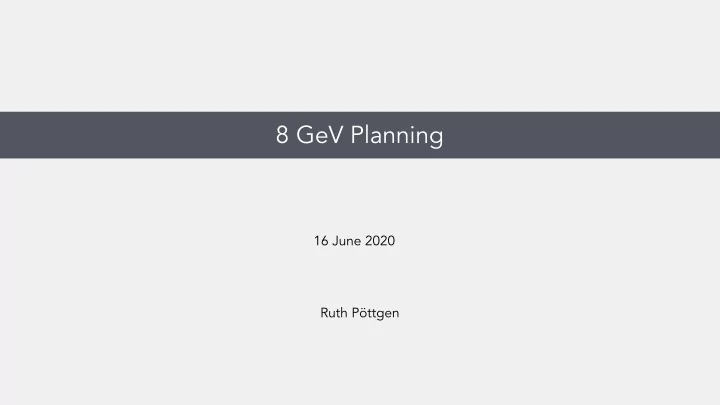

8 GeV Planning 16 June 2020 Ruth Pöttgen
Overview - use Peter’s selection at 4 GeV - Trigger threshold - Trigger skimming (re-reco?) - BDT training (mixed signal + PN) - re-reco to include BDT result - determine BDT cut - apply vetoes, see what is left - if necessary, apply MIP tracking to remaining events + apply to target PN samples + re-do Tom’s studie on shower composition L DM X 16 June 2020 � 2
Peter’s selection Goal: get a more or less direct first comparison of 8 GeV vs 4 GeV to do: - run Peter’s selection on both 8 and 4 GeV - produce a cutflow Time estimate: 1-2 weeks L DM X 16 June 2020 � 3
Trigger Threshold Goal: determine cut on energy in first 20 ECal layers 1 Efficiency to do: - run reco for inclusive samples (~1e7 events in Lund) − 1 10 /projects/hep/fs9/lunarc_nobackup_users/ pflorido/ldmx20Apr/mc-data/v9/8.0GeV/ Sum of Layers 1-20 mc_v9-8GeV-1e-inclusive* m = 1 MeV − 2 10 A' - write an analyser script for inclusive background m = 5 MeV A' m = 10 MeV based on e.g. existing PN analyser A' m = 1000 MeV A' - implement calculation of energy sum in first 20 layers − 3 10 - Inclusive 4 GeV e - produce plot like the one on the right for signal and inclusive background sample − 4 10 —> determine reasonable trigger threshold @4 GeV − 5 Time estimate: ~2 weeks 10 0 500 1000 1500 2000 2500 3000 3500 4000 Trigger Missing Energy [MeV] not sure why this is not 1 trigger missing energy: (figure caption says it is the “trigger rate for all beam energy - energy in first 20 layers backgrounds induced by beam electrons”) L DM X 16 June 2020 4 �
Trigger Skimming Goal: reduce sample size, produce inputs for BDT training to do: - re-reco (Lene can provide an example?) with trigger skimming in place - in reco config things like from LDMX.EventProc.simpleTrigger import simpleTrigger simpleTrigger.parameters["threshold"] = <triggerThreshold/MeV> simpleTrigger.parameters["end_layer"] = 20 p.sequence=[ecalDigis, …, simpleTrigger , …] p.skimDefaultIsDrop() p.skimConsider("simpleTrigger") Time estimate: ~1 week L DM X 16 June 2020 � 5
BDT Training + Re-reco Goal: retrain Gabrielle BDT on 8 GeV (i.e. no new variables etc.) and determine cut value to do: - produce training samples - mix events from 4 signal samples with different masses - subset of ECal PN backgrounds - follow Valentina’s instructions (see backup) —> produces a new pkl file - re-reco with that pkl file to get BDT result in output Time estimate: ~3 weeks L DM X 16 June 2020 � 6
Veto Sequence Goal: repeat ~same event selection as for 4 GeV veto paper to do: - determine BDT threshold to be used (signal efficiency vs. background rejection) - adapt PN analyser to include vetoes as in paper - trigger - single track - BDT veto - HCal veto (leave unchanged for first try) - see what remains - potentially modify HCal veto - check MIP tracking Time estimate: ~2-3 weeks L DM X 16 June 2020 7 �
Target PN Goal: Get estimate of target PN background to do: - run the same selection on target PN samples Time estimate: ~1 week L DM X 16 June 2020 � 8
Shower Composition Goal: Check conclusion obtained at 4 GeV, that low-energy tail of showers is dominated by events with high-energy photon going PN LDMX Simulation to do: 1 Event Rate − 2 - reproduce Fig 7 from the paper ECal Trigger 10 − 4 10 - generate high-stats (nearly) inclusive sample − 6 10 - disable certain processes − 8 10 - divide events into categories as in Fig 7 E = Total Energy Going PN PN All Events − 10 10 E < 50MeV PN 50MeV < E < 1.2GeV PN − 12 1.2GeV < E < 2.8GeV 10 PN ≥ E 2.8GeV PN − 14 10 0 500 1000 1500 2000 2500 3000 3500 4000 Reconstructed Energy in ECAL [MeV] Time estimate: ~2 weeks (depends on how fast we can generate) L DM X 16 June 2020 � 9
Additional Material
Valentina’s Instructions The scripts used for the paper version can be found here: https://github.com/IncandelaLab/LDMX-scripts/tree/master/EcalVeto bdtTreeMaker.py makes flat ROOT trees to be used for training/ECAL studies (the paths to the ldmx-sw install, input files and output directory can be passed as arguments) bdtMaker.py is used to actually train the BDT from the training subsets that you want to use bdtEval.py can be used to evaluate the BDT score per-event and add it to the flat trees I added a README at some point for our students which should provide step- by-step instructions for the training process: https://github.com/IncandelaLab/LDMX-scripts/blob/master/README.md L DM X 16 June 2020 11 �
Recommend
More recommend